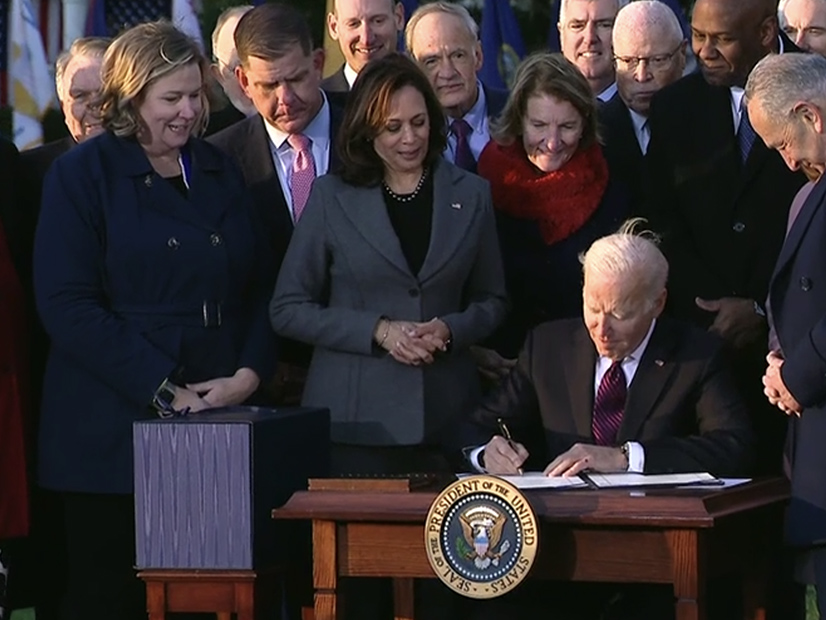
President Joe Biden on Monday signed the $1.2 trillion, bipartisan Infrastructure Investment and Jobs Act (H.R. 3684) in a White House lawn ceremony.
“The bill will enable Americans to get off the sidelines and into the game of manufacturing — solar panels, wind turbines and batteries to store energy and power electric vehicles,” Biden said.
A Department of Energy factsheet listed the energy funding in the bill, which includes more than $7 billion in the supply chain for batteries; $1.5 billion to boost “clean” hydrogen manufacturing and a $750 million grant program supporting advanced energy technology manufacturing projects in coal communities.
It also expands the authority of the DOE’s Loan Program Office, allowing it to invest in projects that increase the domestic supply of critical minerals and expand programs that invest in manufacturing zero-carbon technologies for medium- and heavy-duty vehicles, trains, aircraft and marine transportation.
“Today’s infrastructure bill will also begin the necessary efforts to prevent the worst of climate change, putting thousands of Americans to work by investing in resilience in our buildings and crucially beginning our task to make America’s transportation system clean,” said Senate Majority Leader Chuck Schumer, (D-NY).
The bill drew praise from across the energy sector.
“Enactment today of the bipartisan Infrastructure Investment and Jobs Act puts in motion critical upgrades to our nation’s antiquated electric transmission infrastructure, an essential component of achieving a modern and decarbonized grid,” said Gregory Wetstone, CEO of the American Council on Renewable Energy.
Wetstone also urged Congress to pass the Democrats’ $1.75 trillion Build Back Better budget package to spur further investments in renewable energy, energy storage and advanced grid technologies. The infrastructure bill was approved Nov. 5, with some progressives supporting it in return for a procedural vote setting up the budget vote for action after an analysis by the Congressional Budget Office. (See Energy Groups Quick to Praise Infrastructure Bill Passage.)
“This historic law will help expedite some of the foundational infrastructure upgrades to our ports and electrical grid needed to spur the creation of a U.S. offshore wind industry,” David Hardy, CEO of Ørsted Offshore North America, said in a statement after attending the ceremony. Ørsted has six U.S. wind farms in development, totaling approximately 4 GW.
The infrastructure bill also invests in programs that will help the country continue to electrify its transportation systems, including charging infrastructure, electric school buses and transit fleets, Leah Rubin Shen, federal policy director at the national business association Advanced Energy Economy, said in a statement.
“This infrastructure bill [helps] ensure greater reliability and resilience, and drive essential R&D for hydrogen, nuclear, and other clean energy sources,” Electric Power Research Institute CEO Arshad Mansoor said in a statement.
Electrification of transportation, buildings and industry will play a crucial role in achieving the U.S. government’s climate goals, Mansoor said.


